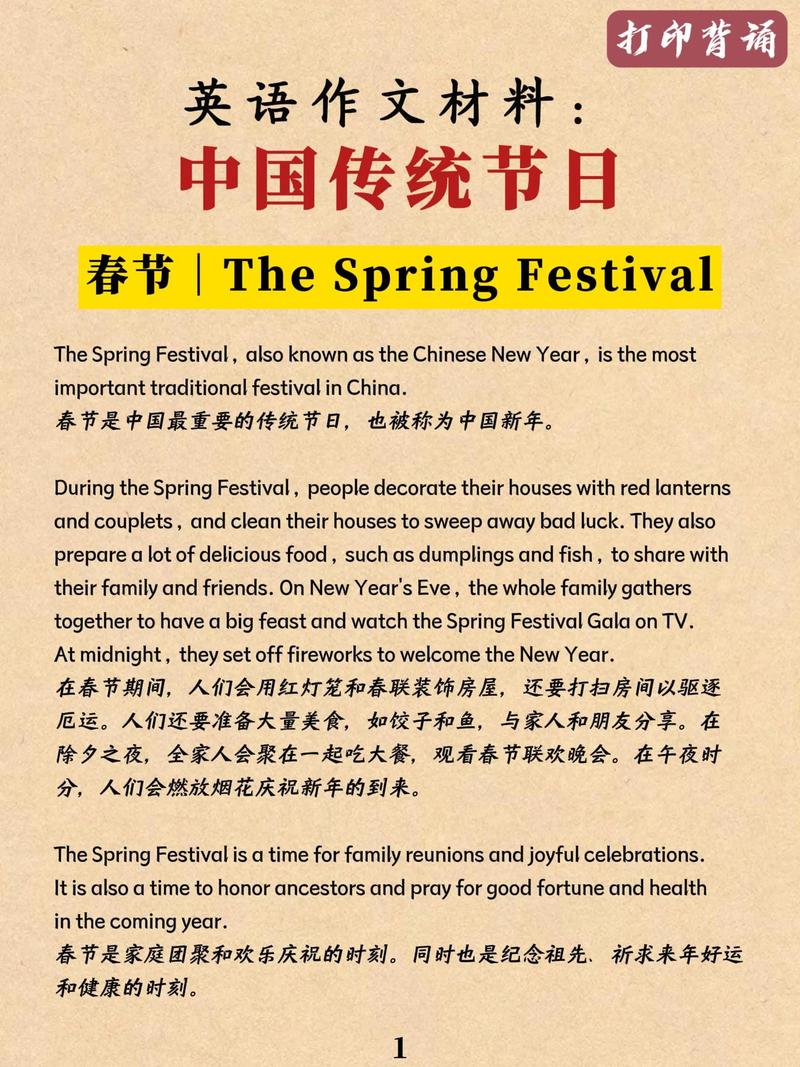本文目录导读:

在全球化日益深入的今天,节日作为不同文化的重要载体,不仅承载着丰富的历史、传统和价值观,还为跨文化交流提供了独特的契机,掌握节日相关的英语表达,不仅能让我们更好地向世界介绍中国的传统佳节,也能更深入地理解其他国家和地区的特色节日,促进文化的相互尊重与融合。
中国传统节日的英语表达与内涵
(一)春节(Spring Festival)
The Spring Festival, also known as the Chinese New Year, is the most important traditional festival in China. It marks the turn of the lunar calendar and usually falls between January 21 and February 20. During this period, people all over the country engage in a wide range of activities to celebrate. Families get together for a sumptuous reunion dinner, where dishes like dumplings, fish, and rice cakes are served with special meanings attached to them. Dumplings symbolize wealth and reunion, while fish represents abundance. Red couplets adorned with auspicious words are pasted on doors, and fireworks light up the night sky, creating a festive atmosphere. Children look forward to receiving red envelopes filled with lucky money from their elders, which brings them good luck and blessings for the new year.
(二)中秋节(Mid-Autumn Festival)
Falling on the 15th day of the eighth lunar month, the Mid-Autumn Festival is a time when family members gather to appreciate the beauty of the full moon. Mooncakes, the iconic food associated with this festival, are shared among friends and relatives. The round shape of the mooncakes signifies unity and completeness. People often sit outdoors, under the starry sky, enjoying mooncakes while reciting poems about the moon. This festival not only provides an opportunity for family bonding but also allows people to reflect on the passage of time and express their longing for loved ones who may be far away.
(三)端午节(Dragon Boat Festival)
Held on the fifth day of the fifth lunar month, the Dragon Boat Festival commemorates the ancient poet Qu Yuan. One of the most prominent features of this festival is the dragon boat race. Teams of rowers paddle fiercely in ornately decorated boats, competing against each other in a thrilling display of strength and teamwork. Zongzi, glutinous rice wrapped in bamboo leaves, are another essential part of the celebration. In addition to the exciting races and delicious food, people also hang mugwort and calamus on their doors to ward off evil spirits and diseases, showcasing the blend of cultural traditions and health beliefs.
西方传统节日的英语表述与特色
(一)圣诞节(Christmas)
Christmas, celebrated on December 25th, is a major religious holiday in Western countries. It commemorates the birth of Jesus Christ. Decorating Christmas trees is a central tradition, with families adorning evergreen trees with twinkling lights, colorful ornaments, and sparkling tinsel. Santa Claus, a legendary character who delivers gifts to children, plays a significant role. Children hang stockings by the fireplace, hoping that Santa will fill them with presents during the night. Carol singing, where groups of people go door-to-door singing Christmas songs, adds to the festive ambiance. Christmas dinner typically includes roast turkey, stuffing, mashed potatoes, and various desserts like pudding and pie.
(二)感恩节(Thanksgiving Day)
Observed on the fourth Thursday of November in the United States, Thanksgiving is a day to give thanks for the harvest and blessings of the past year. It has its origins in a historic feast shared between the Pilgrims and the Native Americans in 1621. A traditional Thanksgiving meal consists of roasted turkey, ham, stuffing, cranberry sauce, sweet potatoes, green bean casserole, and pumpkin pie. Parades, such as the famous Macy's Thanksgiving Day Parade in New York City, are held across the country, featuring colorful floats, marching bands, and performances. Many people also use this day to spend time with family, expressing gratitude for their relationships and the abundance in their lives.
(三)万圣节前夜(Halloween)
On October 31st, Halloween is a fun and spooky holiday primarily for children. Kids dress up in costumes, often depicting ghosts, witches, vampires, or superheroes, and go trick-or-treating. They knock on neighbors' doors, shouting "Trick or treat!" and receive candy or small treats in their bags. Pumpkin carving is another popular activity, with people creating jack-o'-lanterns by carving funny or scary faces into pumpkins and placing candles inside. Haunted houses and horror movie marathons are common forms of entertainment, adding to the eerie and thrilling atmosphere of the night.
节日英语在跨文化交流中的作用
Learning and using festival English enables us to bridge cultural gaps and foster mutual understanding. By sharing information about our own festivals in English, we can introduce unique customs, values, and historical stories to others. For example, explaining the significance of the Chinese zodiac during the Spring Festival can help foreigners gain insights into Chinese astrology and its impact on people's lives. Similarly, learning about Western holidays like Easter and its symbolism of rebirth and hope can enrich our knowledge of Christian traditions and their influence on Western culture.
In conclusion, festival English is a fascinating and meaningful aspect of language learning. It opens doors to different cultures, allowing us to explore the diversity of human celebrations and traditions. Whether it's through sharing stories of our own festivals or participating in international celebrations, let us embrace the joy and cultural exchange that comes with knowing and using festival English.
